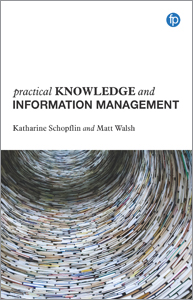
Practical Knowledge and Information Management
Customers outside of North America (USA and Canada) should contact Facet Publishing for purchasing information.
Primary tabs
You don't need to be an ALA Member to purchase from the ALA Store, but you'll be asked to create an online account/profile during the checkout to proceed. This Web Account is for both Members and non-Members.
If you are Tax-Exempt, please verify that your account is currently set up as exempt before placing your order, as our new fulfillment center will need current documentation. Learn how to verify here.
- Description
- Table of Contents
- About the authors
- Reviews
Practical Knowledge and Information Management is a guide written by and for knowledge and information management (KIM) practitioners. As well as offering an introduction to the field, it provides advice and expertise that can be applied to real-life workplace situations. It offers an antidote to hype and best practice you can actually use. Content covered includes
- introducing KIM to organizations;
- information management and governance;
- communities of practice, knowledge sharing and learning;
- knowledge bases, know-how and wikis; and
- after-action reviews, project learning and legacy.
This book will be useful for existing knowledge and information practitioners as well as information professionals increasing their skills in the area. It offers insight for experienced professionals and a good introduction to students and professionals wanting to increase their knowledge.
1 Introduction to knowledge and information management
Definition
The history of knowledge management
The history of information management
How knowledge and information management works
Further reading
2 Introducing knowledge and information management
to organizations
Organizational culture and knowledge and information
management
Who needs knowledge management?
Introducing knowledge and information management
Making the case for knowledge and information management
Further reading
3 Information management and governance
Information and data repositories
Key points of advice for good information management
Governance and policies
Recommended approaches
Further reading
4 Communities and knowledge-sharing
Communication in the workplace
Supporting successful communities
Recommended approaches
Further reading
5 Making knowledge explicit: knowledge bases
know-how and wikis
Knowledge organizing systems
Types of knowledge storage
Recommended approaches
Further reading
6 Capturing knowledge legacy: passing on staff
knowledge
Storytelling and ‘show and tell’
Recommended approaches
After-action reviews and lessons learned
Knowledge capture from departing staff
Recommended approaches
Further reading
Afterword: the future of knowledge and information management
References
Index
- Case studies and sidebars
Chapter 2: Introducing knowledge and information
management to organizations
- Case study 2.1: Making KIM noticed
- Case study 2.2: How not to introduce KIM
Chapter 3: Information management and governance
- Case study 3.1: Core organizational data
- Case study 3.2: The legacy of email
- Sidebar: Six alternatives to email
- Sidebar: A word about controls
Chapter 4: Communities and knowledge-sharing
- Case study 4.1: Managing your online communities
- Case study 4.2: Building a champions network
- Sidebar: What to consider when managing online communities
Chapter 5: Making knowledge explicit: knowledge bases, know-how and wikis
- Case study 5.1: Using your users’ language
- Sidebar: Types of taxonomies in knowledge and information
- management
- Case study 5.2: Managing legal know-how
Chapter 6: Capturing knowledge legacy: passing on staff knowledge
- Case study 6.1: Learning from failure
- Case study 6.2: The Capstone approach
Katharine Schopflin
Katharine Schopflin is a corporate information professional with more than 15 years' experience. She has worked in in a variety of settings, including media, government and non-profit, in roles ranging from research, web content management and knowledge management to cataloging and archive management. Editor of A Handbook for Media Librarians, she publishes regularly on information issues.
Matt Walsh
Matt Walsh is Global Knowledge Manager at Pearson. With 16 years’ experience as knowledge and information management professional, Matt has worked in a variety of different organizations including public and private sector to deliver successful KM and IM solutions.
Praise for the book:
"At a time when organizations need to understand the what, where, who, how and why of their information and knowledge, KIM has a role in enabling them to achieve this. The authors provide a must read for anyone wanting best practice, case studies and guidance on how to get KIM right for their organization. Whether it’s matching KIM practices to organizational culture, or considering different types of KIM activities (IM and governance; knowledge sharing and making tacit knowledge explicit) it’s all here."
- Kate Arnold, Immediate Past President, CILIP
"Whether you're a generalist or a specialist information professional, Schopflin and Walsh's book is packed with helpful commentary and advice. It covers everything from the history, to the state-of-the-art, in KIM, offering a toolbox of ideas, approaches and insights. The best KIM projects rely on clearly-defined purpose, staff buy-in and pragmatic technology choices. This book will help you get it right, no matter what you would like to achieve inside your organization."
- Helen Lippell, Taxonomy, Metadata & Search Consultant


